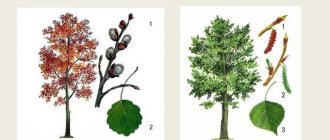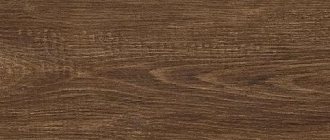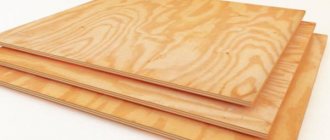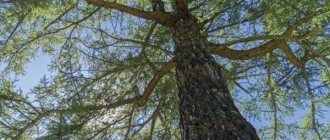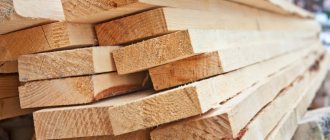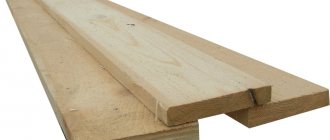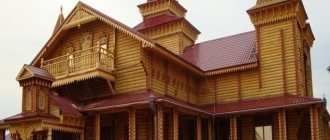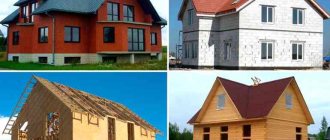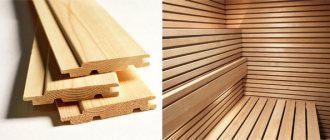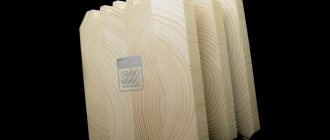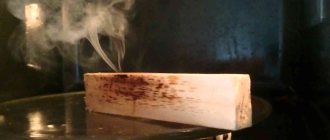The construction market is saturated with a variety of building materials to suit every taste and financial capabilities of developers. Among them there are unique and interesting options, which include dead wood used in low-rise individual construction.
To dismiss a skeptical view of the material, you should get to know it better and appreciate its characteristics and advantages. What is dead wood and how do builders and owners of houses built from dry wood speak about it? Let's figure it out.
Features of building material from dead wood
At first glance, a dried tree that has ceased its vital activity, but is standing on the root and is gradually getting rid of bark, cannot claim to be a high-quality material for construction. But this is a superficial judgment. In fact, dead wood is construction wood that has unique properties. However, material harvested only in polar latitudes, in Karelia (Karelian dead pine), is considered suitable for building a house from dead wood. And that's why. The fact is that, growing in the harsh conditions of the northern climate, where low temperatures and real winter last for six months or more, the tree develops and grows extremely slowly. Over more than a century of age, it reaches a diameter of 20, maximum 50 cm. If you look at the transverse cut of the trunk, you can see that the growth rings are located close to each other, the cyclic growth is insignificant. This explains the extraordinary endurance and strength of wood.
Until recently, the domestic house-building industry did not use dead wood, considering that it was a material unsuitable for these purposes. But the modern experience of foreign colleagues has convinced them that they are mistaken. Houses have been successfully built abroad using such wood material for a long time. Dry wood is especially valued in the Scandinavian countries and Germany, considering dry wood to be the best material in wooden house construction. And calculations carried out by foreign experts confirmed the high qualities of such wood and proved that even if it were in damp soil, it would last about three hundred years. Another confirmation in favor of building wooden housing from dried wood is the fact that our ancestors built log houses from dead wood, and they served their owners for centuries.
A dry tree is devoid of moisture, because it has gone through the process of natural drying over a long period of time (after the cessation of vital activity, a standing tree dries out in 30 - 50 years). Therefore, the wood does not warp, and the structure does not shrink. This is an environmentally friendly material, since the tree grew in a completely clean environment. And in rooms built from dead wood there is a favorable microclimate, which is different:
- optimal level of humidity;
- oxygen balance;
- pleasant smell of natural wood.
If we add to this the natural beauty of the texture of Karelian pine and the fact that dead wood is rarely processed in factories, but more often by hand, all the advantages of its use become obvious.
As for the shortcomings, this is the only one. This is a high price for the material. The cost is explained by the fact that harvesting dead wood is a very complex process, since it is found in hard-to-reach areas in the Karelian forests, often in swampy areas. They remove a dried tree from the ground by the roots, sometimes even using helicopter technology. In addition, no more than 3% of all dead wood meets the required qualities. These factors affect the price of the material.
About drying and building a house
Construction from dry timber is a profitable idea, and the higher cost is explained by the almost complete absence of risks during construction. When choosing the type of lumber, it is useful to know about the methods of drying it; the technology directly affects the quality of drying and the cost of lumber.
Methods for drying timber
The description of GOST 8242-88 states that only timber whose moisture content is less than 20% can be considered dry. Some manufacturers claim that their products have a humidity of about 12-18%, but during operation the wooden walls will pick up some of the moisture from the air, so the final humidity will be at 18%.
There are several ways to dry wood:
- open air. A canopy is constructed, under which beams are stacked (gaps must be left between them). The disadvantages of this drying method can be significant in terms of time, it will take at least 1.5-2 months;
The timber can also be dried in the open air
- drying in a special chamber reduces the process significantly. The essence of the process is that timber of a certain cross-section is loaded into the chamber and the temperature in it rises (the drying temperature regime is selected for each cross-section of the timber);
Chamber drying scheme
Note! The larger the section of the timber, the more difficult it is to dry it, for example, dimensions of 50 by 50 mm guarantee uniform drying, but dimensions of 200 x 200 mm are more difficult to dry.
- There is also a more exotic method of drying - using electricity. Wood is a dielectric by nature, so when electricity is passed through it, it is converted into heat and the timber dries quickly. Due to its high cost, it is used very rarely.
Home construction
The main stages of construction do not differ from building a house from timber of normal humidity.
The instructions include the following steps:
- foundation construction, most often a strip foundation is used;
- Then the actual construction of the walls begins. The key feature of the work at this stage is that only crown laying is possible. Sometimes, in order to protect the first crown from moisture, a board 4-5 cm thick made of hard wood (oak, larch) is laid on the waterproofing of the foundation;
The photo shows the initial stage of construction
- dry beams are usually purchased profiled, so there should not be any particular difficulties with laying the crowns. If a Finnish profile (and its derivatives) is used, then when laying the next crown, a layer of insulation must be laid on the previous one;
The use of insulation with a Finnish profile is mandatory
- special attention is paid to the corners; the “warm corner” type of connection is used, that is, the beams are connected according to the tenon and groove pattern, and insulation is laid in the free space. This design guarantees the absence of drafts;
Warm corner connection
- openings for windows and doors are taken into account at the design stage, and the length of individual beams is selected accordingly, then they can always be trimmed;
- the construction of houses made of dry timber intended for permanent residence requires their mandatory insulation. Otherwise, a wall thickness of 17-20 cm will not be enough to achieve the required thermal conductivity of the wall. Usually 10 cm of insulation is enough.
Houses made of logs and timber from dead wood: pros and cons
Houses for the construction of which high-quality dead wood logs are used have a number of valuable characteristics:
- dead wood is not afraid of mold and pests, bacteria do not grow in it, so it does not require special treatment with antiseptic substances;
- has a long service life: the durability of a log house made from dead Karelian pine is several hundred years;
- cracks and crevices do not form in the wood;
- The building has a beautiful appearance; the wood has a characteristic silvery tint.
Each house built from dry wood material is unique and inimitable, but has a significant drawback - the high cost of the material.
Dead timber is also used in construction, what kind of material is it? This is lumber with a cross-section of 100x100, made from dead wood logs. If high-quality raw materials are used for its production, then the timber has advantages identical to the log:
- low humidity and does not require additional antiseptic protection;
- good strength properties;
- beautiful structure.
Just like a structure made of logs, a house made of dry timber does not shrink and provides an optimal level of ventilation and humidity in the premises.
Advantages and disadvantages of a “green” forest
The most common material in the construction of wooden houses is freshly cut timber. Huge price advantage. The cost is an order of magnitude lower than that of dried wood. However, there is no need to rush. In construction, fresh wood is unpredictable and requires attention.
It is simply not appropriate to use freshly sawn wood. As a rule, such lumber is obtained when freshly felled trees are sawn and sold. Production costs are minimal, and the consequences for construction are sad. During construction, drying naturally, a damp beam or board may lead. Shrinkage occurs and cracks form. The geometry changes.
All this leads to expensive corrections and waste of extra funds. Most of the building materials are simply rejected and used for other needs. It is impossible to predict the behavior of wood during drying naturally, and even more so to predict the consequences. Working with such material is extremely difficult and inconvenient.
Experts do not recommend building a frame from raw timber or boards. The construction process is quite fast, so after the construction of the house, thermal insulation is done. A clogged condition is detrimental for raw wood, therefore there is a high probability of mold and mildew spreading, which negatively affects the quality of the wood.
Other types of dead wood lumber
On the construction market there are offers to purchase edged boards from dead wood. If it is made from selected sawlogs (this is especially true for Karelian pine), then it is considered a quality product. This type of material is suitable for the construction of wooden housing.
However, boards are often made from fallen trees damaged by pests. The wood in them is loose, there are cracks and even wormholes. This material is not suitable for important structural elements of the house. But it is suitable for formwork, temporary fencing, supporting soil in a pit, and scaffolding
Deadwood boards, its pros and cons depend solely on the quality of the wood used and its purpose.
What is TU lumber? Fraud when purchasing lumber.
When choosing a board or timber to build their own house, our compatriots often come across products that are labeled “TU”. Sometimes it is a little cheaper than GOST products, so it is still in demand.
But what's the catch? What makes them different? Why does TU timber have a lower cost?
Lumber with the GOST designation must strictly comply with State standards defining quality indicators, grade, standard cross-sectional dimensions...
Some businessmen have organized a scheme according to which boards or timber with a non-standard cross-section are shipped to customers, so to speak, “according to their own Technical Specifications” (for example, a 22X90 board or 90X140 timber). But they sell this material as products with GOST dimensions (25X100 and 100X150 mm, respectively ).
As a result, it turns out that people pay for non-existent volumes, so such lumber is called “TU”, “Armenian size”, “air”, “construction size lumber”. Let's figure out how this happens in practice, and why it is better to buy high-quality boards and timber from a large manufacturer.
Example
The retail outlet offers 1st grade edged boards with a cross section of 150X25X6000 mm (actually 140X20X6000 mm) at a price of only 7,000 rubles per cubic meter.
The seller purchases a board from the manufacturer with an actual size of 140x20x6000mm (59,524 pieces per 1m3). In total, the truck, if not overloaded, can hold 32 cubic meters of lumber.
The swindler seller sells the board to local customers a little cheaper than usual (to stir up interest in his product) - 7,000 rubles per cubic meter. But he sells this board as lumber 150X25X6000 mm. (accordingly, in a cube, he ships 44.44 or simply 44 boards to the consumer, instead of 59.524).
That is, when purchasing a board, you actually lose 15.524 pieces per cubic meter alone (59.524 - 44.44 pieces). 15 such boards are 0.349 m3, which in monetary terms is 2,443 rubles (0.349 cubic meters X 7,000 rubles).
It turns out that by selling a truckload of boards with a specification size in Moscow, the fraudster receives additional income of 78,176 rubles (32 m3 X 2,443 rubles). This money is blatantly taken from the pockets of a gullible client who is “led” by the tasty price and does not check the geometry of the purchased materials.
PHOTO GOST BOARD
There will definitely be consequences. The 150X100 timber purchased for floor installation in most cases cannot withstand the design load - as a result, the floor creaks and bends. The boards purchased for formwork cannot withstand the pressure of concrete and crack and break. Having purchased beams with an actual size of 140X140 mm instead of 150X150 lumber for the construction of the walls of a house, you will be faced with the fact that you simply do not have enough crowns to obtain the planned ceiling height and at the same time your walls will be thinner than the size specified in the project and, accordingly, you will not significantly, but you will lose on heating in winter.
PHOTO BOARD TU
What conclusions can be drawn from the above?
The main question in this case is how not to be deceived when ordering lumber. To do this, you should follow some simple rules. It is recommended to be personally present during the purchase and loading of the material, carefully monitoring its quality (including the cross-sectional size). If you suspect that they are selling you burnt grass or dead wood, or the sizes do not match the standard, then you need to refuse the purchase.
Dead wood: sawlogs or for the firebox?
Areas of dead forest always produce a rather depressing impression. Some trees suffered as a result of diseases, others - from pests. Sometimes, the percentage of such illiquid timber on a leased plot is quite decent. What to do with this wood? Each logger answers this question independently. Some people don’t bother and leave the illiquid stuff in the forest, some even burn it, but there are tenants who find a use for it.
Dead trees are “dead” trees that continue to stand. These can be either “singles” or entire forest areas that have been subjected to one or another negative impact. In Soviet times, they were often used to produce sleepers, forest industry workers recall. This practice still occurs today, although in our time it is no longer as widespread.
Quality
I would like to immediately say about the quality. As a rule, such wood initially stands in the forest and dries for more than one year. There are times when a tree falls to the ground and partially comes into contact with the grass. What am I talking about? Moreover, the quality of such forest will be very uneven.
For example, one that stands on its own will have cracks in the sapwood, and one that lies on its side may have both cracks and rot.
Therefore, to process such a board, it is necessary to draw up clear technical conditions. Everything should be spelled out in them, which logs go where. In my book, I described everything how to do it correctly.
Now I will briefly mention how you need to think:
- Wood with a rotten core must be set aside in one direction (the amount of rot is necessarily regulated);
- Wood with sapwood rot can also be processed, but the amount of rot must be regulated.
Accordingly, it is necessary to process the rotten core into small timber, while the sapwood rot can be processed into timber.
If we talk about strength, then of course the brilliant green will be stronger, I would say about 20 percent.
Introduction
I became acquainted with this sawmill while working as a technologist at a large woodworking factory. And it all started with the fact that we had a catastrophic shortage of logs in our production. In the forest there were simply huge deposits of substandard timber.
Today the state forces this forest to be disposed of, and while no one sees it, it was burned or delivered to the population in the form of free firewood.
In general, we thought and thought and came up with the idea of sending all the substandard items for recycling. So to speak, do an experiment. Our experiment was a success and I described everything in my new book. I’ll say right away that we didn’t recycle everything and for a reason. Here we need the right approach, which one? Everything is written in the book. In addition to dead wood, we also processed wood that was rotten, crooked, and highly curly. More details about the book in the “BOOKS” section.
How to cut it
Cutting dead logs is quite difficult. Firstly, the consumption of cutting tools increases significantly. I would even say 1.8 - 2.1 times. It all depends on what size you process it into.
Circular saws burn very hotly. Therefore, we had a specially separate kit for these logs.
As for the output coefficient, we can say that it will be overestimated, as expected. Its overestimation depends on the quality of the dead wood. On average, sawlog consumption is increased by 10 - 20% compared to sawing green wood of the same diameters.
We sold lumber in two ways:
- They sawed sawlogs separately into boards and sold the sawnwood at a price lower than green boards;
- Dead wood was mixed into the green forest in a certain proportion. Next, the lumber was sorted as expected and some boards fell into both the first grade with green forest and the grades below. Thus, due to substandard quality, we increased the volume of green lumber.
